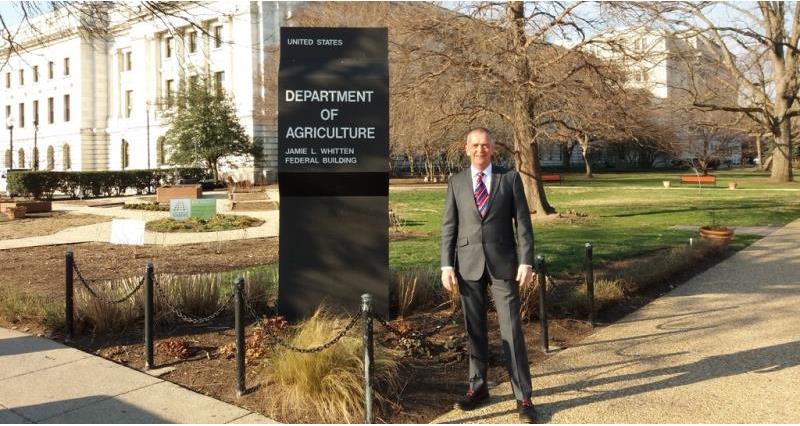NFU Vice President Guy Smith is visiting the USA and Canada this week. Accompanied by NFU economists Lucia Zitti and Rohit Kaushish, the trio are on a fact-finding tour to learn more about international agricultural policy. He writes:
It's an enormous white edifice of a building that sprawls across several blocks in a prime location approaching Capitol Hill.
Just a short walk from the Whitehouse, next to the Washington Memorial, it acts as a statement of intent as to the importance of farming in this great agrarian nation. From sea to shining sea, America produces not only enough food to feed 320 million Americans, in addition it feeds a further 100 million through its 133 billion dollars of exports. And the USDA in Washington is the administrative hub behind this achievement housing 10,000 staff with a further 70,000 employees reaching out from Florida to Alaska and all two million family farmsteads in between.
So what brings an Essex boy to such capital surroundings on a sunny but cold day in March (despite the cold I'm told by USDA staff that the cherry blossom of Capitol Hill is out a fortnight early)?
Joined by two excellent members of NFU staff - Lucia Zitti our trade expert and economist Rohit Kaushish - the idea is to glean information on the future of US agricultural policy.
With British policy in the Brexit mixer it's important to keep tabs on what is happening across the Atlantic. With a new Republican administration in both Congress houses and a radical new President in the White House, it seems the politics of Washington DC feel as volatile as they do in Whitehall at the moment. And just as the UK is thinking about what new directions lay in the road ahead with its own farm policy, so to the US is starting to shape it's new Farm Bill.
The current Farm Bill was passed in 2014 to last four years with a total spend of 500 billion dollars. Eighty per cent of that is spent on what is called 'nutrition' whereby 20% of the American nation are given welfare assistance to buy food. Of the remaining 20% of the 500 billion dollar spend, 13% goes into insurance type programmes to underpin the revenue that keeps US farmers afloat while the remaining 7% goes into conservation programmes.
At first glance to my simple eyes the coupling of what is essentially a farm support programme with a welfare provision based around food handouts seems an odd one. But I'm on a quick learning curve as I enter a round of meetings with impressive USDA staff.
Here's the trick - by creating two key but separate spheres of beneficiaries - these being the US farm economy and the food needs of the urban areas, in one Farm Bill you thereby garner enough political support on Capitol Hill you need to agree to $500 bn of state spending at a time other programmes are being cut in the low tax atmosphere of the new administration. Through one Farm Bill both urban Democrats and rural Republicans can return from Washington with something for their different constituencies.
And USDA officials seemed confident that this solid foundation that underpinned successive Farm Bills stood firm going forward - despite the apparent tremours that are reverberating between the Whitehouse and both houses in the Congress building at moment. Lesson one of day one of my week in America? Politics needn't be complicated.
